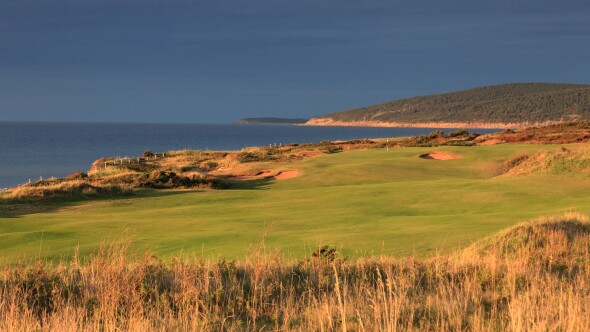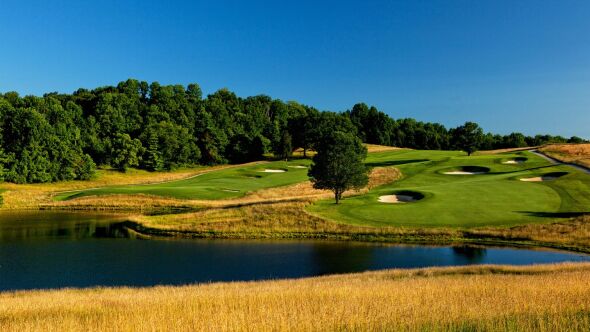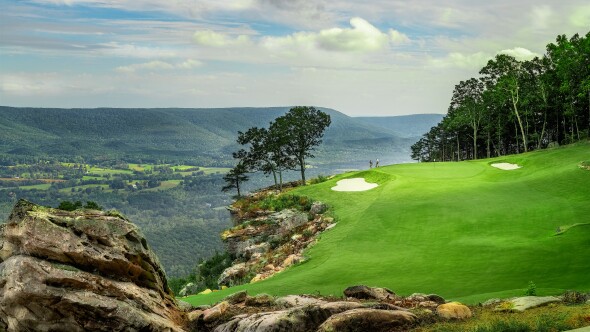Here’s a great way to celebrate Earth Day without guilt. Play golf, and during the round take plenty of time to look around and appreciate everything outside of the immediate tee-fairway-green line. In other words, abandon for the moment worries about your swing or your score and revel in the environment around you.
Case in point: the par-3 eighth hole of the Black Course at Bethpage State Park in Farmingdale, N.Y. The epic-scale layout, originally designed by A.W. Tillinghast, is site of the next month’s PGA Championship. Players who manage the carry across a front pond on the eighth hole can take the time to notice a sign along a walkway by the water proclaiming that “[t]his property has been certified for its achievements in environmental sustainability” by Audubon International.
Bethpage Black is one of five 18-hole courses on the 1,370-acre state park grounds. Collectively, they handle about 225,000 rounds a year, making it one of the busiest golf properties – municipal or otherwise – in the country. It’s also one of the best managed in terms of environmental planning, with fully certified status in the Audubon Cooperative Sanctuary Program. The maintenance staff includes two fulltime naturalists who work closely with Dr. Frank Rossi, associate professor at Cornell University's School of Integrative Science.

Together, they work on reducing pesticide use and in cultivating native areas whose plant composition – big and little bluestem, sedge, prairie dropseed, beach grass and fescues - is more indigenous to central Long Island. For golfers that means a more diverse palette of playing textures. For birds and mammals, it means a more welcoming habitat. Golfers accustomed to striped green playing surfaces find a very different and more engaging presentation at Bethpage. “The high grass areas are the signature areas,” says Rossi.
Changes in attitudes about the environment
Across the country, there’s been a revolution in golf course management and presentation. Golf course use of active chemical agents in maintaining turf has dropped considerably. Water restrictions and declining availability of fresh water in many parts of the country have forced golf courses to adapt to more stringent regulations, and the result is the widespread introduction of non-irrigated native areas. To make sure that the areas reverting to native plants and xeriscape are truly out of play, golf course managers are working closely with a GPS mapping technology developed by the USGA Green Section that monitors play and helps identify low- and non-trafficked areas.
At Ford Plantation in Richmond Hill, Ga., Superintendent Nelson Caron used that GPS technology to map out 14 acres of turf reduction on his Pete Dye-designed, real-estate layout. It’s part of an ambitious plan to expand the way the property, 20 miles southwest of Savannah, fits along the Ogeechee River. Caron has three fulltime naturalists on staff who are dedicated to everything from walking trail extension to bee habitat enhancement, tagging alligators, providing nature guides and signage, and maintaining indigenous tree species that are home, among other things, to horned owls and a pair of bald eagle nests.
Back in the 1920s, Walter Hagen called it “taking time to smell the roses.” The sentiment was appropriate, but his understanding of nature was extremely limited; hardly consistent with the profusion of flora and fauna that is standard on golf courses.
There is no aspect of the modern game more wildly misunderstand than what a golf course does in terms of proving habitat, shelter and space for plant life diversity. In an era of rapid horizontal growth in the form of paving over and construction development, the green space occupied by a golf course has becomes increasingly sacrosanct as a refuge.
Things have changed a lot in how the golf course is managed and how chemicals are used to control turfgrass. Golf course architect Michael J. Hurdzan recalls how things were handled back in the late 1950s and early 1960s when he got his start in the business working on greenkeeper’s crews. Standard operating practice included use of lead, arsenic, cadmium and mercury as tools in the fight against insects and disease. The precise admixture was often a witch’s brew concocted on the spot by a greenkeeper according to personal whim. The craft was more akin to family farming than scientific management.
There was no regulatory oversight and little precaution by the crew to prevent migration of the material that was applied. Hurdzan remembers with a combination of chagrin and awe how “one superintendent would use a spoon to dole out the powdered cadmium, then rinse it and use the same spoon to measure out the coffee grind for the pot he was making.”
Those days are over, thanks to strict monitoring at the local, state and federal levels and bans by the U.S. Environmental Protection Administration of heavy-handed chemicals. Arsenic, for example, was an effective tool to fight fungus infestation and to suppress Poa annua; As a side effect it killed worms. It got phased out of use starting in the late early 1970s, replaced by other, less toxic materials, and as the 5-15 year half-life of arsenical compounds passed, its residual chemical control embedded in the soil was less effective against worms. Evidence of their return in the form of worm casts began to become a problem again.
Worm casts are a nuisance to golfers wearing long pants - as well as a squishy factor impacting ball roll. Nowadays the most effective way to reduce worm populations, says Sam MacKenzie, the director of grounds at Olympia Fields Country Club in Illinois, “is to keep the surface dry.” That entails sustained top-dressing with sand and ensuring air movement and sunlight across the surface.
Concerns about strict environmental controls on golf management originally spawned fears three decades ago that the result would be a shut down of the management industry. In fact, the move has spawned something of a cottage industry among a growing array of ecological consultants and supply firms. Among the many beneficiaries are small companies, like 13-person McCloud Aquatics in Elburn, Ill., 55 miles west of downtown Chicago.
The firm, specializing in pond and lake management, has been focused on the consumer market and commercial property fields for 57 years, but has recently gained a toehold in the golf sector, with a dozen Chicagoland courses in the area currently on its roster. “It’s only a small percentage of our business, but growing,“ says President T.J. McCloud. “Licensed superintendents call us when they cannot maintain algae and weeds on their own and need to maintain water flow and surface clarity.”
Often the need for improved stewardship requires more than everyday maintenance adjustments. That’s where course designers come in. As new golf development has slowed down, there’s been a dramatic uptick in major renovations to make golf courses more ecologically sustainable.
That’s what drove much of designer Andy Staples’ work at a struggling municipal layout in Hobbes, N.M., five years ago named Ocotillo Park Golf Course. Besides showing signs of general neglect, the course was drawing upon town well water, yet the city had need of a place to deploy its supply of effluent. In the course of upgrading the tract and outfitting it with walking trails, Staples built an adjoining par-3 course that made sure the new layout could take recycled water. That meant expanding on-course ponds and providing a feeder from the water treatment plant and hooking it up to a new irrigation system. The course, rechristened Rockwind Community Links, now is the prime user of town effluent and relies upon ground water only as backup.

Ecological adaptation has long been part of what makes golf special. The game isn’t just set in a natural environment. It actively engages the land in terms of soil, climate, drainage, chemistry and politics. Adapting to those demands entails constant adjustment of management strategy. In coming years, we are likely to see golf courses respond to an emerging set of challenges.
The future of natural golf
Climate change has already brought discernible changes to golf courses. Rising coastal water levels are threatening some classic British links as well as low-lying courses in the U.S. Southeast. Hurricane cycles along the Gulf of Mexico have posed recurring problems for courses there. And superintendents throughout the country have noted a double-whammy of altered weather that has entailed longer periods of drought coupled with more intense rain events.
Nor is the political climate likely to cool off. The fact is that about 90 percent of the population does not play golf and all too often this majority sector looks upon golf as an ecological culprit rather than as a friend of the environment. There is likely to be growing pressure for more reductions of nitrogen and phosphates to reduce the overload of water bodies. And recent moves to limit glyphosate-based herbicides will likely mean yet another shift in management strategies for superintendents.
The big difference these days is that golf courses are proving adaptable, as are golfers. Notions of “perfect” set up are evolving, and there’s been a dramatic move away from the notion that a golf course has to sport a uniform, wall-to-wall lush green carpet. The area of active quality maintenance is steadily shrinking, as is the use of chemicals to achieve it. And the naturalization of the ‘frame” through more indigenous plants and soil coverage has meant a return to more classical design values.
And so, as we recognize celebrate Earth Day, it makes sense to celebrate golf courses. They’ve never been more part of nature.



























The thing with the "Greens" and the "Environment" cult, is that whatever improvements are made to better the environment, it's never enough. They always want to move to goalposts and push restrictive regulations further. Greens won't stop demanding more until they have managed to take away our personal cars, our golf courses, other symbols of privilege and most individual liberties.
What a load of garbage! I couldn’t give a rip about this nonsense...my group just wants nice greens and cheap green fees...couldn’t care less about the environment
I really appreciate their efforts to make it "greener". It will help the health of all of us.
Per the link title, I was hoping "guilt-free round" would provide a way to stop thinking about all the things needing to be done around the house while you are golfing or anxiety about running into your boss at the turn.